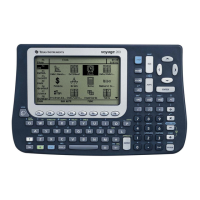876 Appendix A: Functions and Instructions
simult(
coeffMatrix
,
constMatrix
[,
tol
]) ⇒
⇒⇒
⇒
matrix
Solves multiple systems of linear equations,
where each system has the same equation
coefficients but different constants.
Each column in
constMatrix
must contain the
constants for a system of equations. Each column
in the resulting matrix contains the solution for
the corresponding system.
Solve: x + 2y = 1
x + 2y = 2
3x + 4y = ë 1
3x + 4y = ë 3
simult([1,2;3,4],[1,2;ë 1,ë 3])
¸
[
ë 3 ë 7
2 9/2
]
For the first system, x=ë 3 and y=2. For the second
system, x=ë 7 and y=9/2.
sin() W key
sin(
expression1
) ⇒
⇒⇒
⇒
expression
sin(
list1
) ⇒
⇒⇒
⇒
list
sin(
expression1
) returns the sine of the argument
as an expression.
sin(
list1
) returns a list of the sines of all elements
in
list1
.
Note: The argument is interpreted as a degree,
gradian or radian angle, according to the current
angle mode. You can use ó ,
G
or ô to override
the angle mode setting temporarily.
In Degree angle mode:
sin((p/4)ô ) ¸
‡2
2
sin(45)
¸
‡2
2
sin({0,60,90})
¸ {0
‡3
2
1}
In Gradian angle mode:
sin(50) ¸
‡2
2
In Radian angle mode:
sin(p/4) ¸
‡2
2
sin(45
¡) ¸
‡2
2
sin(
squareMatrix1
) ⇒
⇒⇒
⇒
squareMatrix
Returns the matrix sine of
squareMatrix1
. This is
not
the same as calculating the sine of each
element. For information about the calculation
method, refer to
cos().
squareMatrix1
must be diagonalizable. The result
always contains floating-point numbers.
In Radian angle mode:
sin([1,5,3;4,2,1;6,ë 2,1]) ¸
.942… ë.045… ë.031…
ë.045… .949… ë.020…
ë.048… ë.005… .961…
sinê () 2 Q key
sinê (
expression1
) ⇒
⇒⇒
⇒
expression
sinê (
list1
) ⇒
⇒⇒
⇒
list
sinê (
expression1
) returns the angle whose sine is
expression1
as an expression.
sinê (
list1
) returns a list of the inverse sines of
each element of
list1
.
Note: The result is returned as a degree, gradian
or radian angle, according to the current angle
mode setting.
In Degree angle mode:
sinê (1) ¸ 90
In Gradian angle mode:
sinê (1) ¸ 100
In Radian angle mode:
sinê ({0,.2,.5}) ¸
{0 .201... .523...}

